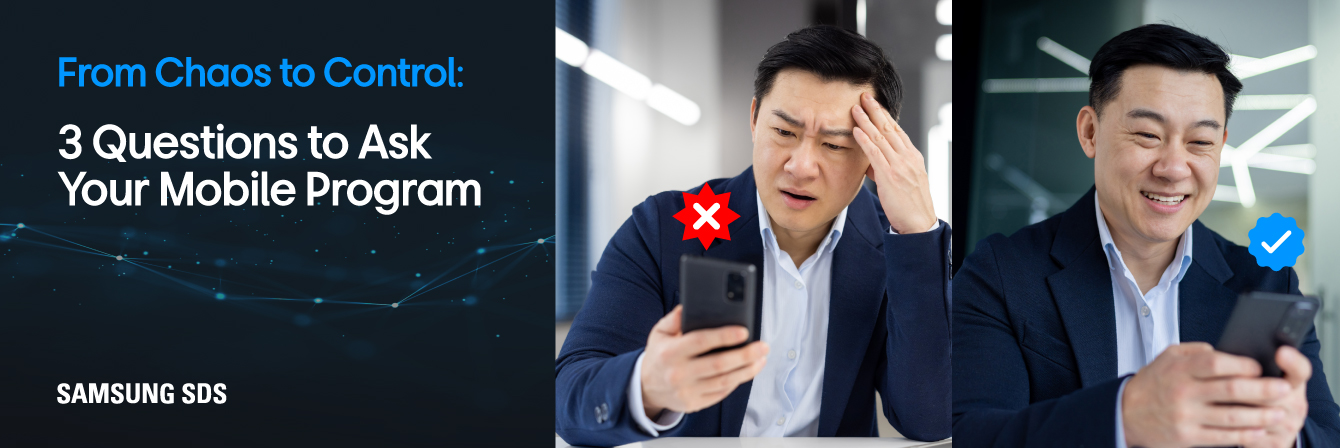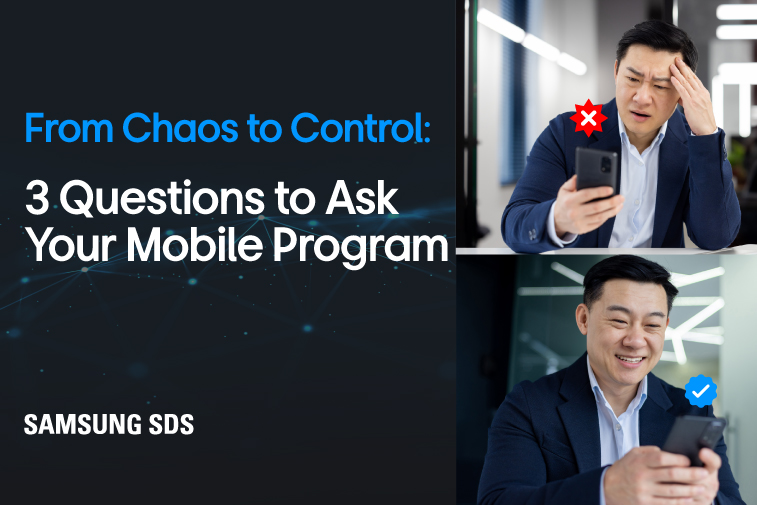
Traditionally, managing a mobile program involved a significant amount of manual effort. This included tasks such as manually updating device inventories, off-boarding and reassigning devices, troubleshooting issues, and coordinating with multiple vendors. Further increasing manual-intensiveness, many organizations relied, and still rely, on swivel-chair operations — switching between different systems to gather information and perform tasks.
For those who still adopt legacy mobile management systems, these manually intensive processes often lead to inefficiencies, errors, and increased labor costs. Next-generation mobile management programs, on the other hand, reduce manual intensiveness while increasing compliance and efficiency via automation, centralization, and real-time monitoring.
All organizations differ in their mobile management needs — what will work for some won’t work for others. Hence, it’s important for IT leaders to ask the right questions to determine whether their mobile program is working for them, or them for it.
If you’re considering the suitability of your current mobile program, ask yourself the following three questions.
Question 1: Does the thought of adding another 1,000 devices instantly strike fear in you and your mobile operations team?
Scalability is a key indicator of product fit. This refers to the ability of your mobile program to handle an increase in workload without a proportional increase in resource consumption. A scalable system should be able to seamlessly absorb and integrate new devices.
If the thought of adding a large number of devices causes concern about the capability of your current infrastructure, it may be an indicator that your mobile program is not sufficiently scalable and may require reevaluation or enhancement.
In the same vein, ask yourself this question: When an employee off-boards, how long does it take for the device to be reassigned to a new employee, or how many steps are involved in a device resale/buyback scenario? While device off-boarding is often a complex and misunderstood process, it’s nonetheless necessary to examine the efficiency and effectiveness of these procedures to better understand the operational agility, responsiveness, and overall suitability of your mobile program.
If your answer to the first question is one of trepidation — and your answer to the second is one of frustration or inefficiency — it strongly indicates a need to modernize your mobile management strategy.
Question 2: Would it take you more than 15 minutes to create a comprehensive scorecard that evaluates the effectiveness of your mobile program, key processes, and vendor performance?
If your answer is yes, it suggests that your mobile management system may not be adequately integrated or automated.
Effective management of a mobile program hinges on rapid access to comprehensive data. If it takes more than 15 minutes to compile a scorecard, or if this process requires aggregating data from various systems, it suggests underlying inefficiencies that must be rectified. An optimally integrated system should enable swift generation of a thorough overview of your mobile program's performance.
Samsung’s Enterprise Mobility Management (EMM) solution, for instance, provides a unified admin console that offers a holistic view of the entire mobile environment. This console integrates device management, application management, and security management into a single dashboard, enabling IT administrators to quickly assess and respond to various situations. This means creating a comprehensive scorecard to evaluate the effectiveness of your mobile program and vendor performance can be accomplished in minutes, not hours, thereby reducing the time and effort required to monitor and manage mobile resources.
Further, on the seamlessness of your mobile program’s information access systems, ask yourself this: Can you measure your mobile device onboarding process? How much manual effort and how long does it take from when an employee starts until they have their mobile device in hand, enrolled, and with all the necessary applications installed to ensure their success?
Access to this information informs not only the efficiency of the onboarding process but also impacts overall employee productivity and satisfaction. A streamlined onboarding process should be quick and largely automated, ensuring that new employees are ready to work with fully equipped and secured devices from day one.
Question 3: Would migrating to a new EMM solution bring your business to a halt, or is it part of a connected and adaptable ecosystem?
Efficient integration is central to the smooth operation of any mobile program, irrespective of the complexity or scale of the enterprise. A flexible ecosystem enables seamless transitions across various systems, including Enterprise Mobility Management (EMM) solutions, without interrupting business operations. Driven by competition and technological advancements, it's business-critical to maintain an ecosystem that can effortlessly incorporate new solutions and enhance overall efficiency.
Moreover, if you made an acquisition and the new company utilized a different EMM, would you be able to integrate their systems smoothly? Can your current infrastructure handle a multiple EMM ecosystem without issues? If not, that’s an indicator that your system lacks the necessary flexibility and adaptability to effectively handle growth and changes.
If you answered yes to any of these questions, Samsung SDS’s Zero Touch Mobility (ZTM) solution can help
Samsung SDS’s ZTM solution enables organizations to streamline their mobile management processes by leveraging automation, seamless integration, and comprehensive visibility. Built on the robust ServiceNow platform, ZTM ensures that your mobile program works for you by offering:
Conclusion
As digital transformation accelerates and more operations migrate to the cloud, implementing Zero Trust models is essential for protecting against evolving cyber threats. By consistently verifying every request, enforcing least privilege access, and leveraging advanced security technologies, organizations can significantly enhance their security, ensure compliance, and boost operational efficiency. Despite the challenges, the strategic benefits of a well-implemented Zero Trust architecture make it an indispensable strategy in contemporary cybersecurity.
- Automation and scalability: By automating routine tasks and workflows, ZTM reduces manual effort and allows your mobile program to scale without a corresponding increase in workload.
- Single pane of glass for mobility: ZTM provides a unified view of your mobile environment and processes already managed within ServiceNow. This centralization allows you to orchestrate and manage your mobile assets alongside other business-critical operations, such as Information Technology Service Management (ITSM), Human Resources Information System (HRIS) management, and IT Operations Management (ITOM).
- Seamless integration: ZTM’s integration with ServiceNow ensures that your mobility ecosystem is connected to your enterprise’s essential functions. This connectivity enhances operational efficiency and ensures that all mobile-related activities are synchronized with your broader IT infrastructure.
Furthermore, ZTM enhances your mobile management with advanced analytics and real-time reporting, integrated security measures protect corporate data and ensure compliance with industry standards, and comprehensive lifecycle management features cover every aspect of device use — from deployment to decommissioning.
Unlike traditional mobile management systems that drain resources, next-generation solutions like Samsung SDS's ZTM empower your organization to best manage its mobile fleets.
If you’re questioning the suitability of your mobile program and would like more insight into how Samsung ZTM can serve your organizational needs, then speak to one of our team members today.

- Hidden costs of poor enterprise device management | Samsung SDS
- 5 mobile lifecycle management best practices | Samsung SDS
- What's New in Zero Touch Mobility 24.08
- The Benefits of ZTM for Managed Service Providers - MSPs
- What's New in Zero Touch Mobility 24.06
- 5 Ways ZTM Provides Enhanced Device Workflows | Samsung SDS
